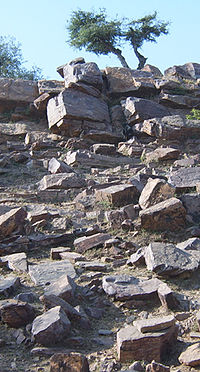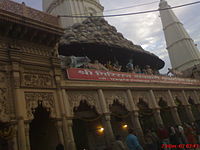- Govardhan hill
-
Govardhan (Sanskrit: गोवर्धन) is a hill located near the town of Vrindavan, in the Mathura district of Uttar Pradesh, India. It considered as sacred by a number of traditions within Hinduism.
Known as Govardhan or Giriraj it is the sacred center of Braj and is identified as a natural form of Krishna.[1]
Contents
Etymology
The name 'Govardhana' has two primary translations. In the literal meaning, 'Go' translates to 'cows', and 'vardhana' translates to 'nourishment'. Another meaning of 'Go' is 'the senses' and 'vardhana' can also mean 'to increase' - thus the name is also translated by devotees of Krishna as 'that which increases the senses' in their attraction to Krishna - In this connection it is believed that the personality of Govardhan blesses the devotee by increasing his devotion (bhakti). Thus by residing in the foothills of Govardhan Hill, all the senses and the respective duties of a soul attain divinity and are more inclined to perform service to Krishna.[citation needed]
The lifting of Govardhan
Govardhan Puja is celebrated the day after Diwali. It is the day Lord Krishna defeated Indra, the deity of thunder and rain. As per the story, Krishna saw huge preparations for the annual offering to Lord Indra and questions his father Nanda about it. He debated with the villagers about what their 'dharma' truly was. They were farmers, they should do their duty and concentrate on farming and protection of their cattle. He continued to say that all human beings should merely do their 'karma', to the best of their ability and not pray or conduct sacrifices for natural phenomenon. The villagers were convinced by Krishna, and did not proceed with the special puja (prayer). Indra was then angered, and flooded the village. Krishna then lifted Mt Govardhan and held it up as protection to his people and cattle from the rain. Indra finally accepted defeat and recognized Krishna as supreme. This aspect of Krishna's life is mostly glossed over - but it actually set up on the basis of the 'karma' philosophy later detailed in the Bhagavat Gita.[citation needed]
It also represents the downfall of Indra, and a new beginning in Hindu philosophy, from a more sacrificial/ appeasement oriented worship, to a more spiritual plane of thought. This evolution of thought in Hinduism was brought about by Krishna, and therefore he has been the most important Hindu deity since then - considered an 'avatar' of the supreme. The more we look at his life story - we find him to be a great reformer of his time.[citation needed]
According to ancient Vaishnava legends the Vedic Deva (God), Indra (God of rain & lightning) was feared by human beings because he would either give the people no rain or flood them if he was not satisfied with their worship. When Krishna found out, he opposed the performance of sacrificial worship for Indra. He emphasized the importance of karma and doing ones duty. This supposedly made Indra angry at the boy Krishna (an incarnation of the Supreme God according to the Bhagavata Purana [2]).
Indra thus invoked many clouds to appear in the sky and schemed to flood the region with rains lasting for seven days and seven nights. Krishna in reply then lifted Govardhan hill, under which all the animals and people of the region took shelter, safe from the rains of Indra's fury. Ultimately, Indra accepted defeat, and after praying to Krishna, left for his heavenly abode, the Svarga.
See also
Notes
- ^ David L. Haberman, River of Love in an Age of Pollution: The Yamuna River of Northern India, Page 264 ISBN 0520247892
- ^ Bhag-P 1.3.28 'Krishna Is the Source of All Incarnations'.
External links
http://www.icompositions.com/music/song.php?sid=170073 Ballad of Govardhana Hill
- The Story of Govardhan
- Image Gallery & Description of Govardhan Hill
- GiriRaj Mandal
- Pictures of Govardhan Hill
- Exclusive video of Parikrama of Govardhan Hill
Hindu deities and texts Gods 
Goddesses Texts Hinduism · Hindu mythology · Indian epic poetry Krishna Forms Worship Holy sites Texts See also Hinduism • Avatar • Svayam Bhagavan • Krishnology • Vishnu • Radha • Rukmini • Satyabhama • Krishna images at WikiCommonsCategories:- Locations in Hindu mythology
- Krishna
- Mathura district
- Hills of India
Wikimedia Foundation. 2010.



